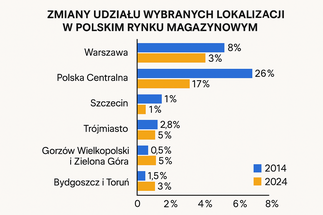Poland dominates the CEE warehouse market - it accounts for over 50% of the space in the region.
Over the last 10 years, Romania, Hungary, and Slovakia have recorded an average threefold increase in the supply of warehouse space, and the Czech Republic has increased its warehouse resources by more than twice (2.5x). Against the background of the CEE region, Poland remains the clear leader, currently accounting for over 50% of the total warehouse space in CEE.
Thanks to its advantageous geographical location, extensive infrastructure, and growing investor interest, Poland is strengthening its position as a key logistics hub in Europe.
Accolade experts predict Poland's warehouse market will stabilise after years of dynamic growth. However, the country still has several significant advantages that can drive further sector development.
- Poland is a phenomenon on the map of the European warehouse market. Over the last decade, the number and area of warehouse projects have increased fourfold, distinguishing Poland from other countries in Central and Eastern Europe, and it has one of the best results in Europe. Poland's excellent geographical location and advantages of the labour market, such as the availability of employees, lower operating costs, flexibility of regulations, and growing demand from the e-commerce and production sectors, are the factors that have determined the dynamic development of this market the most.
Poland is a leader in growth in Central and Eastern Europe.
According to Accolade's analysis based on CBRE data, the Polish warehouse market has developed faster than the average for the Central and Eastern Europe (CEE) region in the last 10 years. The analysis included five countries: Poland, the Czech Republic, Romania, Slovakia and Hungary.
In 2014–2024, warehouse space in Poland increased from 8.82 million m² to 33.86 million m², an impressive 284% increase. For comparison, the total supply of warehouse space in the CEE region increased by 224%—from 19.75 million m² in 2014 to 64.05 million m² in 2024.
At the same time, the number of newly built industrial and logistics facilities in Poland increased significantly. At the end of 2014, there were 224 such facilities, while in 2024, there were already 884—an almost fourfold increase.
In the CEE region, Poland stands out as the country with the most dynamic growth of the warehouse market from 2014 to 2024. During the analysed period, it developed faster than all other countries included in the ranking.
For comparison:
• Romania recorded an increase in the supply of warehouse space by 215%,
• Slovakia – 203%,
• Hungary – 199%,
• Czech Republic – 141%.
Meanwhile, Poland can boast an increase of as much as 284%, which places it as the absolute leader of the warehouse market in the CEE region.
Demand for warehouses also skyrocketed. In 2024, 5.86 million sq m of warehouse and production space was leased in Poland, compared to 2.58 million sq m 10 years earlier (+127%).
Less often Warsaw, more often Szczecin and Tricity
For years, industrial investors' most significant activity in Poland has been concentrated around five key markets: Warsaw, Central Poland, Upper and Lower Silesia, and Poznań. However, their dominance on the country's warehouse map is gradually weakening.
According to CBRE data, in 2024, these five main locations accounted for 75% of the total warehouse space in Poland, while in 2014, their share was as much as 90%.
This decline is indicative of the ongoing diversification of the logistics market and the growing importance of new warehouse locations, such as the Tri-City, Szczecin, Lublin, Rzeszów, or Bydgoszcz-Toruń, which attract investors thanks to their advantageous location, developing infrastructure, and lower operating costs.
Over the last 10 years, Poland's warehouse market's geographical structure has changed significantly. Traditionally, strong locations, such as Warsaw and Central Poland, are losing their share of the domestic supply of warehouse space. Warsaw's share fell from 8% in 2014 to less than 3% in 2024, and Central Poland's share fell from almost 26% to over 17% in the same period. At the same time, the importance of new warehouse markets is growing, and they are increasingly chosen by tenants, especially from the e-commerce and manufacturing sectors. For example:
• Szczecin increased its share from less than 1% in 2014 to almost 4% in 2024.
• Tricity almost doubled its share, from 2.8% to 5%
• Gorzów Wielkopolski and Zielona Góra recorded a tenfold increase from 0.5% to 5%
• Bydgoszcz and Toruń doubled their share to almost 3% in 2024
These data confirm the progressive decentralisation of the warehouse market in Poland and the growing role of smaller but strategically located locations. These locations benefit from developing infrastructure, the availability of labour, and the growing demand for flexible logistics solutions.
Stabilisation after dynamic growth
As the Accolade representative emphasises, after years of intensive development, the market is entering a stabilisation phase, which, for many investors, is an opportunity for long-term, well-thought-out decisions.
"We have a few aces up our sleeve - Poland still has strong advantages, such as its geographical location, infrastructure development and the growing attractiveness of smaller markets, which will drive further development of the warehouse sector," the expert summarises.
"In 2024, every fourth euro invested in commercial real estate in Poland concerned warehouses. In total, investors invested EUR 1.26 billion in industrial facilities, which is a result higher by 31% year-on-year. According to Joanna Sinkiewicz, " greater interest is a good prognosis for the coming years because capital is one of the accelerators of this market and is necessary for it to continue to develop stably. And she adds that Poland still has a few "aces up its sleeve".
- A huge advantage is the flexibility of the market. A new investment from purchasing land to the commencement of operations can be completed in a dozen or so months. This is a unique situation in Europe. Additionally, warehouse facilities in Poland are relatively very young. We have almost no properties from the 90s or 80s, which often dominate in Western Europe. Our warehouses are modern, increasingly automated and equipped with energy-saving solutions, which are currently the tipping point for investors and tenants. And finally, it is hard to imagine the functioning of more dynamically developing sectors of the Polish economy, such as trade or logistics, without warehouses, so for purely practical reasons, it is and will be an indispensable product, says Joanna Sinkiewicz from Accolade.




